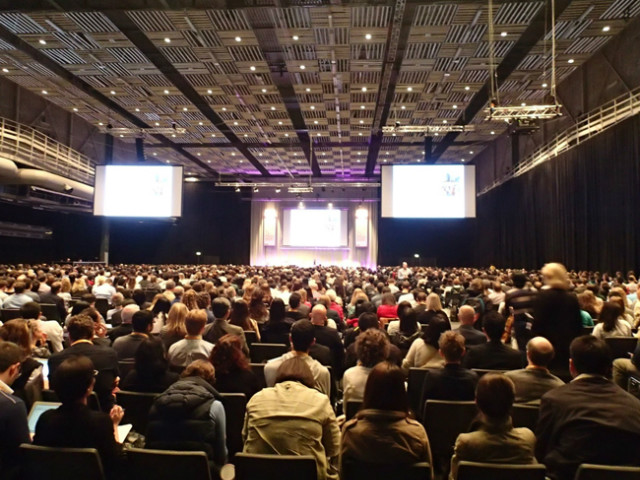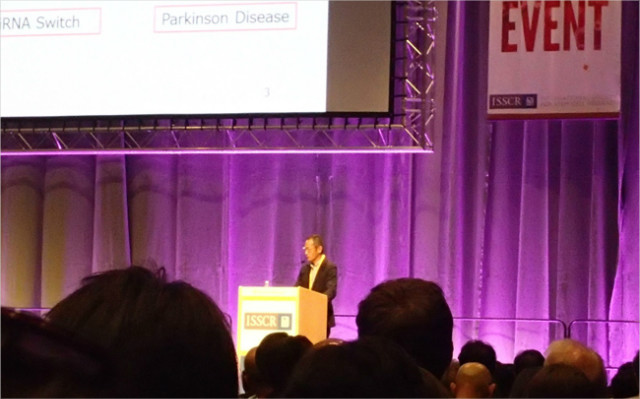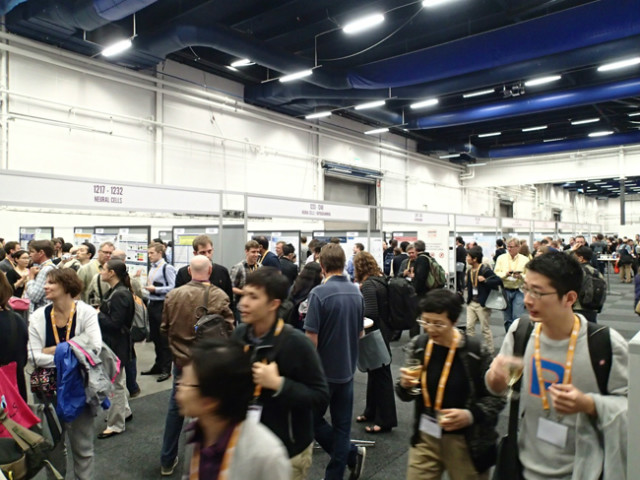기술동향
ISSCR 2015 참석 후기
- 등록일2015-07-20
- 조회수7345
- 분류기술동향
-
자료발간일
2015-07-14
-
출처
BRIC (생물학연구정보센터)
- 원문링크
-
키워드
#ISSCR 2015#줄기세포#학회#스웨덴 스톡홀름 컨벤션 센터#야마나카 신야
- 첨부파일
출처 : BRIC (생물학연구정보센터)
ISSCR 2015 참석 후기
저자 : 류지나 (서울대학교)
요약문
2015년 6월 24-27일 스웨덴 스톡홀름 컨벤션 센터 (Stockholmsmassan exhibition and con-vention center)에서 13th ISSCR (International Society for Stem Cell Research)가 진행되었다. 2012년 iPSC (induced pluripotent stem cell)로 노벨 생리의학상을 수상한 야마나카 신야 (Yamanaka Shinya) 교수가 주축을 이루어 5,000여 명의 전세계 줄기세포 연구자들이 스톡홀름에 모였다. 학회기간 동안 170명이 넘는 저명한 인사들의 plenary lecture와 concurrent session을 통해 많은 지식을 얻을 수 있었고 1,600개가 넘는 poster가 3일 동안 발표 되어 열띤 토론의 장이 마련 되었다.
키워드: ISSCR, 줄기세포(ES), 유도만능줄기세포(iPS cell)
분야: Biotechnology
목차
Ⅰ. 주된 발표 내용
1. 6월 24일 주요 내용
Plenary Ⅰ. Manipulating stem cells in development and disease
Plenary Ⅱ. Regeneration and engraftment
2. 6월 25일 주요 내용
Plenary Ⅲ. Disease modeling
3. 6월 26일 주요 내용
Plenary Ⅳ. Pluripotency and mechanisms of reprogramming
Plenary Ⅴ. Therapy with stem cells
4. 6월 27일 주요 내용
Plenary Ⅵ. Immunology and stem cells
Plenary Ⅶ. Making tissues and organs
Ⅱ. 총평
Ⅰ. 주된 발표 내용
1. 6월 24일 주요 내용
Plenary Ⅰ. Manipulating stem cells in development and disease
Plenary Ⅱ. Regeneration and engraftment
2. 6월 25일 주요 내용
Plenary Ⅲ. Disease modeling
3. 6월 26일 주요 내용
Plenary Ⅳ. Pluripotency and mechanisms of reprogramming
Plenary Ⅴ. Therapy with stem cells
4. 6월 27일 주요 내용
Plenary Ⅵ. Immunology and stem cells
Plenary Ⅶ. Making tissues and organs
Ⅱ. 총평
Ⅰ. 주된 발표 내용

Plenary hall의 모습. 3,000석이 넘는 좌석이 모자라 뒤에 서있는 사람들이 있을 정도로 전세계의 많은 줄기세포 연구자들이 한자리에 모였다.
1. 6월 24일 주요 내용
Plenary Ⅰ. Manipulating stem cells in development and disease
1) Somatic mosaicism and genomic diversity: LINE-1 (long interspersed nucleotide elements-1 or L1)은 somatic neuronal progenitor cells (NPCs)에서 신경세포 다양성에 중요한 역할을 한다. L1은 retrotransposition을 하여 신경세포 분화에서 single neuron의 유전적 정보를 변화시킨다. 따라서 이러한 element의 영향으로 individual brain은 다양성 (variety)과 유연성 (flexibility)을 가짐으로 독창성을 가지게 된다.
2) Modeling human brain development and disease in 3D culture: 복잡한 인간의 뇌를 모방하기 위하여 2D culture는 적당하지가 않다. Knoblich의 연구팀 (Austria)에서는 human pluripotent stem cell을 이용하여 3D-organoid culture system을 개발하였다. 이러한 모델은 cerebral cortex를 포함하여 뇌의 다양한 부분을 만들 수 있었으며, 소두증 환자의 iPS cells로 3D-organoid를 만들어 이러한 질병이 특정단백질 (CDK5RAP2)이 부족하여 생기는 것을 밝혀냈다. 이러한 3D organoid는 뇌뿐만 아니라 실제 사람의 복잡한 organ을 in vitro상에서 모방하여 질병의 기작을 밝혀낼 수 있을 것으로 기대된다.
3) Recent progress in iPS cell application: 최근 Yamanaka 연구팀 (Japan)에서는 만들어진 iPS cell line에 대한 characterization으로 실제 치료에 사용될 수 있을만한 quality를 지닌 세포를 선별하는 작업들을 계속 진행 하고 있다. 또한 특정 sequence를 target하는 miRNA를 만들어 이를 switch처럼 사용하고 있는데, 이러한 miRNA switch는 세포를 특정 lineage로 분화했을 때 이를 sorting하는것으로 이용될 수 있다. 예를 들어 miRNA-Bim switch를 cardiomyocyte 분화에 이용하여 이쪽으로 분화한 세포만을 살리고, 나머지 세포들은 apoptosis를 일으킴으로써 sorting을 하였다. 마지막으로 Takahashi 연구팀 (Japan)은 iPS cell을 파킨슨병에 이용하기 위해 Corin+ DA neurons을 실제 환자의 치료제로 이용하려는 연구를 진행하고 있다.
Plenary Ⅰ. Manipulating stem cells in development and disease
1) Somatic mosaicism and genomic diversity: LINE-1 (long interspersed nucleotide elements-1 or L1)은 somatic neuronal progenitor cells (NPCs)에서 신경세포 다양성에 중요한 역할을 한다. L1은 retrotransposition을 하여 신경세포 분화에서 single neuron의 유전적 정보를 변화시킨다. 따라서 이러한 element의 영향으로 individual brain은 다양성 (variety)과 유연성 (flexibility)을 가짐으로 독창성을 가지게 된다.
2) Modeling human brain development and disease in 3D culture: 복잡한 인간의 뇌를 모방하기 위하여 2D culture는 적당하지가 않다. Knoblich의 연구팀 (Austria)에서는 human pluripotent stem cell을 이용하여 3D-organoid culture system을 개발하였다. 이러한 모델은 cerebral cortex를 포함하여 뇌의 다양한 부분을 만들 수 있었으며, 소두증 환자의 iPS cells로 3D-organoid를 만들어 이러한 질병이 특정단백질 (CDK5RAP2)이 부족하여 생기는 것을 밝혀냈다. 이러한 3D organoid는 뇌뿐만 아니라 실제 사람의 복잡한 organ을 in vitro상에서 모방하여 질병의 기작을 밝혀낼 수 있을 것으로 기대된다.
3) Recent progress in iPS cell application: 최근 Yamanaka 연구팀 (Japan)에서는 만들어진 iPS cell line에 대한 characterization으로 실제 치료에 사용될 수 있을만한 quality를 지닌 세포를 선별하는 작업들을 계속 진행 하고 있다. 또한 특정 sequence를 target하는 miRNA를 만들어 이를 switch처럼 사용하고 있는데, 이러한 miRNA switch는 세포를 특정 lineage로 분화했을 때 이를 sorting하는것으로 이용될 수 있다. 예를 들어 miRNA-Bim switch를 cardiomyocyte 분화에 이용하여 이쪽으로 분화한 세포만을 살리고, 나머지 세포들은 apoptosis를 일으킴으로써 sorting을 하였다. 마지막으로 Takahashi 연구팀 (Japan)은 iPS cell을 파킨슨병에 이용하기 위해 Corin+ DA neurons을 실제 환자의 치료제로 이용하려는 연구를 진행하고 있다.

iPS cell로 노벨상을 수상했던 야마나카 교수의 plenary lecture 모습. 동서양을 막론하고 모든 사람들이 그의 한마디 한마디에 집중하고 있다.
Plenary Ⅱ. Regeneration and engraftment
1) Adult neurogenesis in humans: Hippocampal neuron은 사람의 전 일생 동안 지속적으로 생성되며 교체가 이루어 진다. 이러한 neuron의 생성속도는 사람의 경우 middle aged부터 변화하는데, 이는 사람이 나이를 먹음에 따라 neurogenesis가 감소하는 요인이 되기도 한다. 사람마다 adult neurogenesis는 독특한 (unique) 패턴을 가지며 Huntington’s disease를 가진 환자의 경우에는 특히 adult born striatal neuron의 부족현상을 보인다. 따라서 다양한 종류의 neurogenesis가 인간의 pathology에 어떠한 영향을 끼치는지 연구가 진행되고 있다.
2) Targeting endothelial growth factor pathways in cancer and cardiovascular disease: 암환자들에게 anti-angiogenic drugs가 이용되고 있지만 대부분의 환자는 거부반응이 일어난다. 따라서 angiogenesis inhibitor와 함께 약 물질을 처리하는 것도 효과를 올릴 수 있는 하나의 방법이다. 반대적으로 cardiovascular disease 환자에게 아예 growth factor를 이용하여 pro-angiogenesis를 일으킴으로써 새로운 blood vessel을 생성하여 blood flow를 회복시키는 것도 새로운 방법이다.
3) Molecular circuitry controlling regeneration of a patterned limb: Salamander의 limb 재생에서는 복잡한 형태를 지닌 multi-tissue 구조를 재생한다는 점을 주목해보아야 한다. 기존의 연구들은 connective tissue cells이 limb의 재생에서 핵심적인 위치 정보를 지니고 있으며 anterior specified tissue와 posterior specified tissue의 상호작용이 반드시 필요함을 보여주고 있다. Tanaka의 연구팀 (Germany)은 anterior cells과 posterior cells 간의 상호작용 기반에 존재하는 molecular circuitry를 찾아냈으며, 이것이 limb의 성장과 구조화를 통합시키는데 필요하다는 것을 밝혀냈다.
2. 6월 25일 주요 내용
Plenary Ⅲ. Disease modeling
1) Lung stem cell approaches to understanding differentiation disease and therapy: 폐 말단에서는 bronchioalveolar stem cells (BASCs), bronchiolar club (Clara) cells, alveolar type Ⅱ cells (AT2 cells), alveolar progenitors 와 같은 stem/progenitor cell이 손상된 폐를 복구하는데 관여한다. 하지만 어떻게 이런 multipotent stem cells이 선택적으로 손상된 부분만 대체하는지에 대해서는 잘 알려져 있지 않다. 연구진은 endothelial cells과 distal lung stem cells을 3D co-culture 하는 기술을 개발하여, BASCs가 bronchiolar와 alveolar differentiation potential을 지녔음을 확인했다. 또한 BASCs의 alveolar differentiation을 유도하는 BMP-NFATcⅠ/calcineurin/TSPⅠ pathway를 발견했다. 이러한 발견은 폐 질환과 폐암에서의 특정 타깃이 될 수 있는 pathway를 설명해주는 동시에 세포 수준에서 호흡기 질환의 mechanism을 이해하는 새로운 시각을 제공해줄 것이다.
2) LGR5 stem cells in self-renewal and cancer: Leucine-rich repeat-containing G-protein coupled Receptor 5 (LGR5)는 Wnt target gene이며, LGR5는 장 외에도 다양한 조직에 존재하는 stem cell에 대한 generic biomarker이다. LGR5+ve crypt base columnar cells (CBC)는 장의 모든 상피세포로 분화할 수 있는 능력을 지니고 있으며, 이를 활용하여 ever-expanding crypt-villus or-ganoids, 혹은 3D culture를 통한 “mini-guts” 등을 만들 수 있다. Intestinal cancer는 APC와 같은 gene에서 Wnt pathway를 activate하는 mutation에 의해 시작될 수 있는데, crypt base에 존재하는 stem cells만 APC를 deletion하여도 neoplasia가 성장함을 확인했다. 이는 cancer stem cell라는 개념을 지지해주는 근거라고 볼 수 있다.
3) Modeling epigenetic disorders using human pluripotent stem cells: Human pluripotent stem cell은 human epigenetic disorders를 modeling 할 수 있는 가능성을 지니고 있다. Benvenisty의 연구팀 (Israel)은 모계 염색체만 지니도록 처녀생식을 하는 human iPS cells을 만들었다. 이를 일반적인 pluripotent stem cell과 비교함으로써 여러 imprinted differentially methylation regions (iDMRs)를 발견했다. 본 연구진은 부계의 각인 유전자 발현이 일어나지 않을 때 발생하는 유전자 질환인 Prader-Willi syndrome (PWS)을 위와 같은 방법으로 연구했다. 그 결과 모계의 각인 유전자에 의한 up-regulation을 확인할 수 있었고, 기존에 예상했던 것과는 달리 두 개의 각인 유전자가 발현을 복잡하게 조절하고 있음을 밝혀냈다.
4) Transgenic marmosets for modeling human diseases and developing new regenerative therapies: 다양한 stem cell lines의 개발은 새로운 재생의약품을 개발하여 장기이상과 같은 방면에 쓰일 가능성을 지니고 있다. 그러나 이런 stem cell therapies가 실제로 적용되기 위해서는 반드시 안전성과 효율성에 대한 검사가 필요하다. 따라서 동물 model을 통하여 임상전의 연구가 필요하다. Sasaki의 연구진 (Japan)은 유인원의 한 종류인 marmoset을 동물 model로 이용하였다. Marmoset은 임신 주기가 짧고, 효율 좋은 reproductive techniques의 protocol이 확립되어 있다. 이런 생물적인 특징 덕분에 transgenic human disease marmoset을 만들 수 있었다. Transgenic marmoset은 인간 질병 model 뿐만 아니라 재생의약품 연구에서의 model로 활용될 수 있다.
5) Human glial progenitor cell-based treatment and modeling of neurological disease: 성인 인간의 뇌에 가장 많이 존재하는 전구세포는 glial progenitor cells이다. 따라서 glial cells과 관련된 질병은 progenitor cell-based therapy로 접근할 수 있다. Myelin과 관련된 질병들은 iPS cell에서 얻어낸 glial progenitor 뿐만 아니라 조직이나 stem cell에서 얻어낸 glial progenitor을 이식함으로써 해결될 수 있는 가능성을 가지고 있다. 또 인간의 glial progenitor를 쥐에게 이식함으로써 glial chimeric mice를 만들 수 있다. 이러한 쥐는 glia가 관여하는 human brain disease에 대한 포괄적인 model로 이용될 수 있다.

학회가 열렸던 Stockholmsmassan, 학회이름표를 목에 걸고 다니는 사람들이 곳곳에 보인다.
3. 6월 26일 주요 내용
Plenary Ⅳ. Pluripotency and mechanisms of reprogramming
1) The histone chaperone CAF-1 safeguards somatic cell identity during tranion factor-induced reprogramming: RNAi를 이용하여 mouse iPS cells이 만들어지는 과정에서 어떠한 chromatin regulator가 관여하는지 screen을 한 결과 chromatin assembly factor-1 (CAF-1) complex가 lysine sumoylation, DNA methylation에 중요한 역할을 한다는 것을 밝혀냈다. 이어 CAF-1를 임의로 억제하자 iPS cells로 가는 reprogramming 효율이 증가하는 것을 확인하였다.
2) Progression from the embryonic stem cell ground state: 일반적인 stem cell 배지 상에서 ES cells은 균일한 형태로, self-renewal의 특징을 가진 강한 ground state 성질을 나타낸다. 하지만 이러한 ground state가 깨지면 금방 multilineage로 분화가 이루어지는데, ES cells의 state를 쉽게 알아 볼 수 있도록 genome-wide screen과 multiplex molecular machinery characterization 기술이 개발되고 있다.
3) Cell fate decisions during somatic cell reprogramming: Somatic cells이 iPS cells이 되기 전에 중간단계인 EMT-MET process를 거친다. 따라서 reprogramming에 있어 mesenchymal과 epi-thelial fate 사이의 switch는 매우 중요하다. Pei 연구팀(China)에서는 vitamin C를 reprogramming 과정에 개입시킴으로써 MET로 가는 효율을 늘려 결과적으로 iPS cells을 더 많이 만들 수 있었다. 또한 c-Jun이 MET로 가는 길을 막는다는 것을 밝히고, c-Jun inhibitor를 이용하여 reprogramming의 효율을 높였다.
Plenary Ⅴ. Therapy with stem cells
1) Clinical translation of neural stem cell transplantation: emerging safety and preliminary efficacy with human central nervous system stem cells: Human neural stem cell의 transplantation은 치료용으로 많이 사용되고 있다. 특히 Human central nervous system stem cells (HuCNS-SC®)을 많이 사용하는데 이는 이미 preclinical research를 완료하여 미국 FDA로부터 승인을 받은 상태이다. 요즘에는 HuCNS-SC®을 이용하여 fatal lysosomal storage disease, fatal dysmyelination disorder등의 질병을 치료하고 있다.
2) Generating functional human beta cells from stem cells: 배아줄기세포 (embryonic stem cells)와 유도만능줄기세포 (induced pluripotent stem cells)을 이용하여 이를 beta cells과 같은 functional human endocrine cells로 분화시켰다. 이렇게 분화시킨 세포를 면역이 없는 쥐에 이식하였을 때 physiological function이 나타남을 확인하였다.
3) Development of an encapsulated stem cell therapy for diabetes: ViaCyte 연구소(USA)에서는 혈액 속 glucose를 조절할 수 있는 pancreatic endoderm cells (PEC-01)을 생성하였으며, 이를 치료에 적용하기 위해 PEC-01을 durable macroencapsulation device를 이용하여 운반하는 것을 임상단계에서 시작하였다. 자세한 사항은 웹사이트 참조 [https://www.clinicaltrial.gov: NCT02239354]
4) Bringing mesenchymal stem cells (MSCs) into the clinic: MSCs는 alloreactive donor의 anti-host T-cell response를 억제한다는 점에서 acute infusional toxicity가 없으며, 따라서 환자에게 직접 투여하는 치료가 활발히 이루어지고 있다. 하지만 얼마만큼의 세포를 사용해야 하는지, 어떠한 passage의 세포를 사용해야 하는지 등의 optimization은 아직 MSC treatment의 풀어 나가야 할 숙제이다.
1) Adult neurogenesis in humans: Hippocampal neuron은 사람의 전 일생 동안 지속적으로 생성되며 교체가 이루어 진다. 이러한 neuron의 생성속도는 사람의 경우 middle aged부터 변화하는데, 이는 사람이 나이를 먹음에 따라 neurogenesis가 감소하는 요인이 되기도 한다. 사람마다 adult neurogenesis는 독특한 (unique) 패턴을 가지며 Huntington’s disease를 가진 환자의 경우에는 특히 adult born striatal neuron의 부족현상을 보인다. 따라서 다양한 종류의 neurogenesis가 인간의 pathology에 어떠한 영향을 끼치는지 연구가 진행되고 있다.
2) Targeting endothelial growth factor pathways in cancer and cardiovascular disease: 암환자들에게 anti-angiogenic drugs가 이용되고 있지만 대부분의 환자는 거부반응이 일어난다. 따라서 angiogenesis inhibitor와 함께 약 물질을 처리하는 것도 효과를 올릴 수 있는 하나의 방법이다. 반대적으로 cardiovascular disease 환자에게 아예 growth factor를 이용하여 pro-angiogenesis를 일으킴으로써 새로운 blood vessel을 생성하여 blood flow를 회복시키는 것도 새로운 방법이다.
3) Molecular circuitry controlling regeneration of a patterned limb: Salamander의 limb 재생에서는 복잡한 형태를 지닌 multi-tissue 구조를 재생한다는 점을 주목해보아야 한다. 기존의 연구들은 connective tissue cells이 limb의 재생에서 핵심적인 위치 정보를 지니고 있으며 anterior specified tissue와 posterior specified tissue의 상호작용이 반드시 필요함을 보여주고 있다. Tanaka의 연구팀 (Germany)은 anterior cells과 posterior cells 간의 상호작용 기반에 존재하는 molecular circuitry를 찾아냈으며, 이것이 limb의 성장과 구조화를 통합시키는데 필요하다는 것을 밝혀냈다.
2. 6월 25일 주요 내용
Plenary Ⅲ. Disease modeling
1) Lung stem cell approaches to understanding differentiation disease and therapy: 폐 말단에서는 bronchioalveolar stem cells (BASCs), bronchiolar club (Clara) cells, alveolar type Ⅱ cells (AT2 cells), alveolar progenitors 와 같은 stem/progenitor cell이 손상된 폐를 복구하는데 관여한다. 하지만 어떻게 이런 multipotent stem cells이 선택적으로 손상된 부분만 대체하는지에 대해서는 잘 알려져 있지 않다. 연구진은 endothelial cells과 distal lung stem cells을 3D co-culture 하는 기술을 개발하여, BASCs가 bronchiolar와 alveolar differentiation potential을 지녔음을 확인했다. 또한 BASCs의 alveolar differentiation을 유도하는 BMP-NFATcⅠ/calcineurin/TSPⅠ pathway를 발견했다. 이러한 발견은 폐 질환과 폐암에서의 특정 타깃이 될 수 있는 pathway를 설명해주는 동시에 세포 수준에서 호흡기 질환의 mechanism을 이해하는 새로운 시각을 제공해줄 것이다.
2) LGR5 stem cells in self-renewal and cancer: Leucine-rich repeat-containing G-protein coupled Receptor 5 (LGR5)는 Wnt target gene이며, LGR5는 장 외에도 다양한 조직에 존재하는 stem cell에 대한 generic biomarker이다. LGR5+ve crypt base columnar cells (CBC)는 장의 모든 상피세포로 분화할 수 있는 능력을 지니고 있으며, 이를 활용하여 ever-expanding crypt-villus or-ganoids, 혹은 3D culture를 통한 “mini-guts” 등을 만들 수 있다. Intestinal cancer는 APC와 같은 gene에서 Wnt pathway를 activate하는 mutation에 의해 시작될 수 있는데, crypt base에 존재하는 stem cells만 APC를 deletion하여도 neoplasia가 성장함을 확인했다. 이는 cancer stem cell라는 개념을 지지해주는 근거라고 볼 수 있다.
3) Modeling epigenetic disorders using human pluripotent stem cells: Human pluripotent stem cell은 human epigenetic disorders를 modeling 할 수 있는 가능성을 지니고 있다. Benvenisty의 연구팀 (Israel)은 모계 염색체만 지니도록 처녀생식을 하는 human iPS cells을 만들었다. 이를 일반적인 pluripotent stem cell과 비교함으로써 여러 imprinted differentially methylation regions (iDMRs)를 발견했다. 본 연구진은 부계의 각인 유전자 발현이 일어나지 않을 때 발생하는 유전자 질환인 Prader-Willi syndrome (PWS)을 위와 같은 방법으로 연구했다. 그 결과 모계의 각인 유전자에 의한 up-regulation을 확인할 수 있었고, 기존에 예상했던 것과는 달리 두 개의 각인 유전자가 발현을 복잡하게 조절하고 있음을 밝혀냈다.
4) Transgenic marmosets for modeling human diseases and developing new regenerative therapies: 다양한 stem cell lines의 개발은 새로운 재생의약품을 개발하여 장기이상과 같은 방면에 쓰일 가능성을 지니고 있다. 그러나 이런 stem cell therapies가 실제로 적용되기 위해서는 반드시 안전성과 효율성에 대한 검사가 필요하다. 따라서 동물 model을 통하여 임상전의 연구가 필요하다. Sasaki의 연구진 (Japan)은 유인원의 한 종류인 marmoset을 동물 model로 이용하였다. Marmoset은 임신 주기가 짧고, 효율 좋은 reproductive techniques의 protocol이 확립되어 있다. 이런 생물적인 특징 덕분에 transgenic human disease marmoset을 만들 수 있었다. Transgenic marmoset은 인간 질병 model 뿐만 아니라 재생의약품 연구에서의 model로 활용될 수 있다.
5) Human glial progenitor cell-based treatment and modeling of neurological disease: 성인 인간의 뇌에 가장 많이 존재하는 전구세포는 glial progenitor cells이다. 따라서 glial cells과 관련된 질병은 progenitor cell-based therapy로 접근할 수 있다. Myelin과 관련된 질병들은 iPS cell에서 얻어낸 glial progenitor 뿐만 아니라 조직이나 stem cell에서 얻어낸 glial progenitor을 이식함으로써 해결될 수 있는 가능성을 가지고 있다. 또 인간의 glial progenitor를 쥐에게 이식함으로써 glial chimeric mice를 만들 수 있다. 이러한 쥐는 glia가 관여하는 human brain disease에 대한 포괄적인 model로 이용될 수 있다.

학회가 열렸던 Stockholmsmassan, 학회이름표를 목에 걸고 다니는 사람들이 곳곳에 보인다.
3. 6월 26일 주요 내용
Plenary Ⅳ. Pluripotency and mechanisms of reprogramming
1) The histone chaperone CAF-1 safeguards somatic cell identity during tranion factor-induced reprogramming: RNAi를 이용하여 mouse iPS cells이 만들어지는 과정에서 어떠한 chromatin regulator가 관여하는지 screen을 한 결과 chromatin assembly factor-1 (CAF-1) complex가 lysine sumoylation, DNA methylation에 중요한 역할을 한다는 것을 밝혀냈다. 이어 CAF-1를 임의로 억제하자 iPS cells로 가는 reprogramming 효율이 증가하는 것을 확인하였다.
2) Progression from the embryonic stem cell ground state: 일반적인 stem cell 배지 상에서 ES cells은 균일한 형태로, self-renewal의 특징을 가진 강한 ground state 성질을 나타낸다. 하지만 이러한 ground state가 깨지면 금방 multilineage로 분화가 이루어지는데, ES cells의 state를 쉽게 알아 볼 수 있도록 genome-wide screen과 multiplex molecular machinery characterization 기술이 개발되고 있다.
3) Cell fate decisions during somatic cell reprogramming: Somatic cells이 iPS cells이 되기 전에 중간단계인 EMT-MET process를 거친다. 따라서 reprogramming에 있어 mesenchymal과 epi-thelial fate 사이의 switch는 매우 중요하다. Pei 연구팀(China)에서는 vitamin C를 reprogramming 과정에 개입시킴으로써 MET로 가는 효율을 늘려 결과적으로 iPS cells을 더 많이 만들 수 있었다. 또한 c-Jun이 MET로 가는 길을 막는다는 것을 밝히고, c-Jun inhibitor를 이용하여 reprogramming의 효율을 높였다.
Plenary Ⅴ. Therapy with stem cells
1) Clinical translation of neural stem cell transplantation: emerging safety and preliminary efficacy with human central nervous system stem cells: Human neural stem cell의 transplantation은 치료용으로 많이 사용되고 있다. 특히 Human central nervous system stem cells (HuCNS-SC®)을 많이 사용하는데 이는 이미 preclinical research를 완료하여 미국 FDA로부터 승인을 받은 상태이다. 요즘에는 HuCNS-SC®을 이용하여 fatal lysosomal storage disease, fatal dysmyelination disorder등의 질병을 치료하고 있다.
2) Generating functional human beta cells from stem cells: 배아줄기세포 (embryonic stem cells)와 유도만능줄기세포 (induced pluripotent stem cells)을 이용하여 이를 beta cells과 같은 functional human endocrine cells로 분화시켰다. 이렇게 분화시킨 세포를 면역이 없는 쥐에 이식하였을 때 physiological function이 나타남을 확인하였다.
3) Development of an encapsulated stem cell therapy for diabetes: ViaCyte 연구소(USA)에서는 혈액 속 glucose를 조절할 수 있는 pancreatic endoderm cells (PEC-01)을 생성하였으며, 이를 치료에 적용하기 위해 PEC-01을 durable macroencapsulation device를 이용하여 운반하는 것을 임상단계에서 시작하였다. 자세한 사항은 웹사이트 참조 [https://www.clinicaltrial.gov: NCT02239354]
4) Bringing mesenchymal stem cells (MSCs) into the clinic: MSCs는 alloreactive donor의 anti-host T-cell response를 억제한다는 점에서 acute infusional toxicity가 없으며, 따라서 환자에게 직접 투여하는 치료가 활발히 이루어지고 있다. 하지만 얼마만큼의 세포를 사용해야 하는지, 어떠한 passage의 세포를 사용해야 하는지 등의 optimization은 아직 MSC treatment의 풀어 나가야 할 숙제이다.

Poster발표장. 125개의 exhibit booths가 설치되었고, 1,600개 이상의 posters가 3일의 poster session동안 발표되었다. 포스터 앞에서 열정적인 토론을 벌이고 있는 많은 이들의 모습이 보인다.
4. 6월 27일 주요 내용
Plenary Ⅵ. Immunology and stem cells
1) Adoptive T cell therapy with engineered T cells: Adoptive cell transfer (ACT)란 면역관련 세포를 유입함으로써 환자를 치료를 하는 것으로 요즘에는 면역세포를 engineering함으로써 그 효율을 더 올리고 있다. 예를 들어 T cell에 인위적으로 receptor가 더 발현되게 하여 암환자에게 유입함으로써 cancer cell을 더 효율적으로 target하여 죽일 수 있다. 또한 advanced B cell leukemi-nas를 CD19-specific CART cells과 함께 환자에게 유입함으로써 solid tumor 치료에 더 효과를 볼 수 있었다.
2) Hematopoietic stem cell gene therapy with lentiviral vector in 4 patients with cerebral X-linked adrenoleukodystrophy: long-term outcome: 부신백질이영양증 (adren-oleukodystrophy; ALD)은 X 염색체와 관련되어 있어 주로 남자에게 발생하는 유전병이다. ALD의 치료는 주로 allogeneic hematopoietic stem cell transplantation (HCT)을 이용하여 brain microglia를 대체하는 것으로 이루어 지고 있다. 하지만 이러한 HCT는 수많은 위험성을 내제하고 있다. 2006~2010년의 기간 동안 inflammatory cerebral ALD를 가진 4명의 환자들에게 autologous HSC와 full myeloablation을 일으키는 lentivirus vector (LV)를 함께 주입하여 치료를 진행하였다. 그 결과 abnormal growth없이 allogeneic HCT와 유사한 효과를 나타냄을 보였다. 따라서 LV를 이용한 접근은 치료의 효율성과 동시에 안전성도 올릴 수 있을 것으로 예상된다.
3) From stem cells to T cells, in vitro applications and in vivo implications: human progenitor T-cells (pro-T)을 OP9-DLI stromal cells과 함께 배양한 후 CD34+ CD7++ 의 성질을 가진 pro-T cells만을 sorting하여 면역 억제 쥐에 이식하였다. 그 결과 in vitro의 pro-T cells이 in vivo의 thymus로 homing하여 engraft/reconstitute하는 것을 관찰하였다.
Plenary Ⅶ. Making tissues and organs
1) Cellular reprogramming approaches for cardiovascular disease: Tranion factor와 miRNA function간의 network는 세포의 분화 (differentiation)와 분열 (proliferation) 사이의 결정요소가 된다. 이러한 network는 cardiogenesis 과정에서 cardiac progenitors의 분화와 morphogenetic event에 크게 관여한다. Srivastava 연구팀 (USA)은 cardiac developmental gene의 mutation이 질병을 어떻게 유도하는지를 보기 위해 환자에게서 세포를 얻어 reprogramming을 진행하였다. 이러한 연구는 cardiac 질병을 가진 사람들에게 초기 분화과정에서 부족한 factor가 무엇인지 알게 함으로써 치료에 적용할 수 있겠다.
2) Local and systemic regulators of aging phenotypes in mammalian tissues: 사람이 나이가 들어감에 따라 조직재생을 담당하는 stem cell의 효과가 달라지는데 이는 physiological, pathological한 signal이 stem cell의 기능을 조절하는 것으로 보인다. Parabiosis와 transplantation model을 이용하여 이러한 signal을 제공하는 주요 source가 circulatory system이라는 것을 밝혀냈다.
3) Retinal cell therapy using iPS cells: aged-related macular degeneration (AMD)은 retinal pigment epithelium (RPE)의 노화로부터 일어나는 질병이다. 연구진은 이러한 환자의 iPS세포를 이용하여 손상된 RPE를 새로운 것으로 대체하는 치료를 목표로 면역결핍 쥐에서 tumorigenicity test등의 안전성을 검토하고 있다.
4) New materials and tissue engineering: implantable scaffold를 만들기 위해 새로운 material들이 시도 중이다. 특히 biocompatible synthetic polymers, shape memory degradable polymer, novel rubbery polymer등을 이용하여 이를 human embryonic stem cells에 적용하고자 하는 노력들이 이루어지고 있다.
Ⅱ. 총평
이번 학회는 13번째 열리는 ISSCR의 annual meeting으로 줄기세포의 관심이 뜨거운 요즘, 그에 걸맞게 수많은 사람들이 한자리에 모여 수많은 지식의 전달과 함께 열띤 토론을 벌이는 자리가 되었다. 7개의 plenary lecture는 줄기세포 분야에서 내로라 하는 전문가들로 구성이 되어 배아줄기세포 (embryonic stem cell), 성체줄기세포 (adult stem cell), 유도만능줄기세포 (induced pluripotent stem cell; iPSCs) 등의 다양한 분야에서 접근이 되었다. 또한 이번 학회에서는 ‘disease modeling’, ‘making tissues and organs’등의 session을 크게 가지며, stem cell의 분화 (differentiation)나 기작 (mechanism) 연구에 그치지 않고, 이를 이용한 실질적인 치료에 있어서도 좀 더 적극적인 태도를 보이는 듯 하였다.
한국에서도 서울대학교, 카이스트, 가톨릭대학교 등의 대학기관과 한국생명공학연구원 (KRIBB), 국립보건연구원 (KNIH) 등의 연구기관들에서 참석을 했다.
Plenary Ⅵ. Immunology and stem cells
1) Adoptive T cell therapy with engineered T cells: Adoptive cell transfer (ACT)란 면역관련 세포를 유입함으로써 환자를 치료를 하는 것으로 요즘에는 면역세포를 engineering함으로써 그 효율을 더 올리고 있다. 예를 들어 T cell에 인위적으로 receptor가 더 발현되게 하여 암환자에게 유입함으로써 cancer cell을 더 효율적으로 target하여 죽일 수 있다. 또한 advanced B cell leukemi-nas를 CD19-specific CART cells과 함께 환자에게 유입함으로써 solid tumor 치료에 더 효과를 볼 수 있었다.
2) Hematopoietic stem cell gene therapy with lentiviral vector in 4 patients with cerebral X-linked adrenoleukodystrophy: long-term outcome: 부신백질이영양증 (adren-oleukodystrophy; ALD)은 X 염색체와 관련되어 있어 주로 남자에게 발생하는 유전병이다. ALD의 치료는 주로 allogeneic hematopoietic stem cell transplantation (HCT)을 이용하여 brain microglia를 대체하는 것으로 이루어 지고 있다. 하지만 이러한 HCT는 수많은 위험성을 내제하고 있다. 2006~2010년의 기간 동안 inflammatory cerebral ALD를 가진 4명의 환자들에게 autologous HSC와 full myeloablation을 일으키는 lentivirus vector (LV)를 함께 주입하여 치료를 진행하였다. 그 결과 abnormal growth없이 allogeneic HCT와 유사한 효과를 나타냄을 보였다. 따라서 LV를 이용한 접근은 치료의 효율성과 동시에 안전성도 올릴 수 있을 것으로 예상된다.
3) From stem cells to T cells, in vitro applications and in vivo implications: human progenitor T-cells (pro-T)을 OP9-DLI stromal cells과 함께 배양한 후 CD34+ CD7++ 의 성질을 가진 pro-T cells만을 sorting하여 면역 억제 쥐에 이식하였다. 그 결과 in vitro의 pro-T cells이 in vivo의 thymus로 homing하여 engraft/reconstitute하는 것을 관찰하였다.
Plenary Ⅶ. Making tissues and organs
1) Cellular reprogramming approaches for cardiovascular disease: Tranion factor와 miRNA function간의 network는 세포의 분화 (differentiation)와 분열 (proliferation) 사이의 결정요소가 된다. 이러한 network는 cardiogenesis 과정에서 cardiac progenitors의 분화와 morphogenetic event에 크게 관여한다. Srivastava 연구팀 (USA)은 cardiac developmental gene의 mutation이 질병을 어떻게 유도하는지를 보기 위해 환자에게서 세포를 얻어 reprogramming을 진행하였다. 이러한 연구는 cardiac 질병을 가진 사람들에게 초기 분화과정에서 부족한 factor가 무엇인지 알게 함으로써 치료에 적용할 수 있겠다.
2) Local and systemic regulators of aging phenotypes in mammalian tissues: 사람이 나이가 들어감에 따라 조직재생을 담당하는 stem cell의 효과가 달라지는데 이는 physiological, pathological한 signal이 stem cell의 기능을 조절하는 것으로 보인다. Parabiosis와 transplantation model을 이용하여 이러한 signal을 제공하는 주요 source가 circulatory system이라는 것을 밝혀냈다.
3) Retinal cell therapy using iPS cells: aged-related macular degeneration (AMD)은 retinal pigment epithelium (RPE)의 노화로부터 일어나는 질병이다. 연구진은 이러한 환자의 iPS세포를 이용하여 손상된 RPE를 새로운 것으로 대체하는 치료를 목표로 면역결핍 쥐에서 tumorigenicity test등의 안전성을 검토하고 있다.
4) New materials and tissue engineering: implantable scaffold를 만들기 위해 새로운 material들이 시도 중이다. 특히 biocompatible synthetic polymers, shape memory degradable polymer, novel rubbery polymer등을 이용하여 이를 human embryonic stem cells에 적용하고자 하는 노력들이 이루어지고 있다.
Ⅱ. 총평
이번 학회는 13번째 열리는 ISSCR의 annual meeting으로 줄기세포의 관심이 뜨거운 요즘, 그에 걸맞게 수많은 사람들이 한자리에 모여 수많은 지식의 전달과 함께 열띤 토론을 벌이는 자리가 되었다. 7개의 plenary lecture는 줄기세포 분야에서 내로라 하는 전문가들로 구성이 되어 배아줄기세포 (embryonic stem cell), 성체줄기세포 (adult stem cell), 유도만능줄기세포 (induced pluripotent stem cell; iPSCs) 등의 다양한 분야에서 접근이 되었다. 또한 이번 학회에서는 ‘disease modeling’, ‘making tissues and organs’등의 session을 크게 가지며, stem cell의 분화 (differentiation)나 기작 (mechanism) 연구에 그치지 않고, 이를 이용한 실질적인 치료에 있어서도 좀 더 적극적인 태도를 보이는 듯 하였다.
한국에서도 서울대학교, 카이스트, 가톨릭대학교 등의 대학기관과 한국생명공학연구원 (KRIBB), 국립보건연구원 (KNIH) 등의 연구기관들에서 참석을 했다.

하늘과 바다와 그리고 건물이 아름답게 어우러진 스웨덴의 모습.
☞ 자세한 내용은 내용바로가기 또는 첨부파일을 이용하시기 바랍니다.
-
이전글
- 암 집단발생과 암 역학조사 소개
-
다음글
- 바이러스 이야기
관련정보
지식
동향


 pdf_0002355.pdf
pdf_0002355.pdf